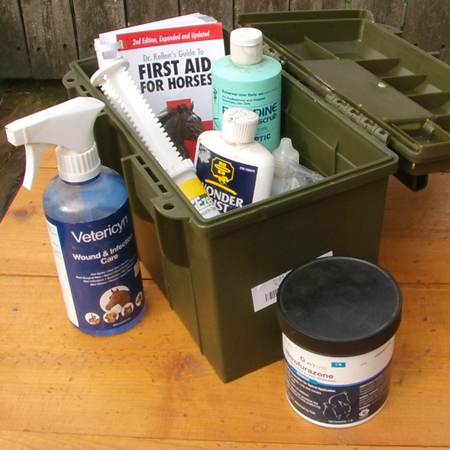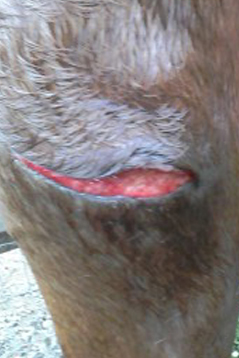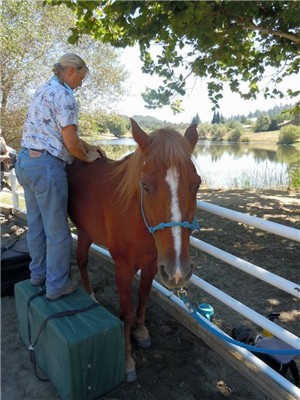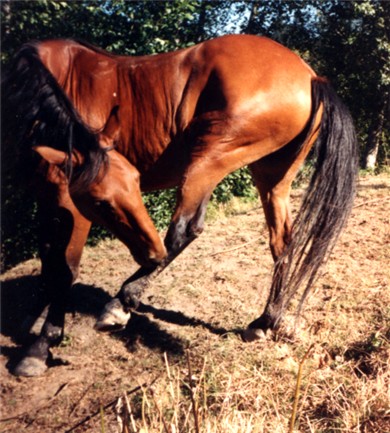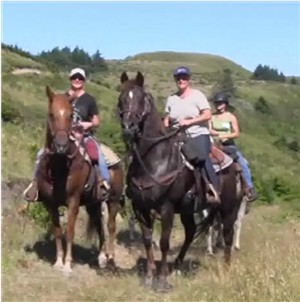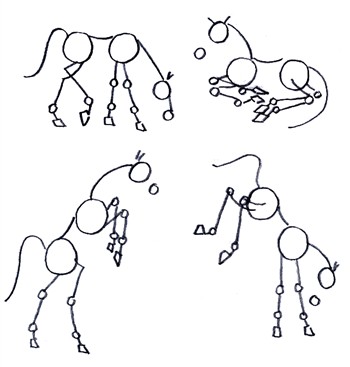Horse First Aid Kit: Better than
Your Store Bought Kit
Every horse owner needs an horse first aid kit. Actually you need two or three. One for the barn, one for the truck and a mini kit for trail rides. A store bought first aid kit is a good place to start, but in reality they are too small and sorely lacking in the medications you really need on hand.
Store bought equine first aid kits are often so skimpy it makes me wonder if the creators have ever dealt with a horse emergency or wound care. You can build a better kit for less money.
Because you never know when or where you'll be when your horse gets hurt, you'll want the supplies needed to treat your horse until you can get them to a veterinarian. You'll also want to have the items on hand to manage wound care after your vet has treated the animal.
You will find there are many instances that you can care for your horse without the need of a vet if you have a proper first aid kit.
Did You Know?
Individually wrapped sanitary napkins, both thick and thin, make wonderful bandages. They are sterile and inexpensive. They can be cut down to size and the cotton side used to apply medication directly to a wound before wrapping.
One of the first things you're going to need is a sturdy zippered duffle bag to hold all of your supplies, most of which are bulky. A canvas duffle with handles is preferred over a plastic bin because it can easily be carried to the horse, wherever they may be.
If your store bought kit comes with a small plastic case, use it to hold all of your cotton bandage pads.
It stands to reason that your your largest and most complete first aid kit will be kept at the barn. It is likely to grow more complete over time. This is a well rounded list of supplies for a practical horse emergency care kit.

Horse First Aid Kit Basic Supplies
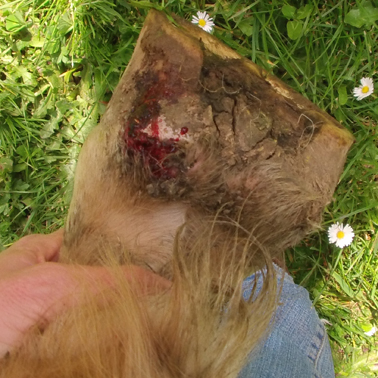 Accidents happen
Accidents happen- Several rolls of vet wrap (Store in a large plastic zip lock bag to keep soft, pliable and sticky)
- Cotton roll
- Gauze pads 4x4
- Sanitary pads
- Disposable baby diapers (water them down, place in freezer, then use as an ice wrap)
- Bandage scissors
- Digital or traditional rectal thermometer (Note: attach a string with clip to your thermometer so you don't loose it in the animal)
- K-Y Jelly (lubricate your thermometer please)
- rubber gloves
- A bottle of Hydrogen peroxide
- A bottle of Rubbing alcohol
- A bottle of Betadine
- Roll of paper towels (can be used under vet wrap as bandaging in a real pinch)
- Roll of duct tape (has several uses from taping separated hooves to re-enforcing bandages. Note: don't use duct tape directly on horse hair or skin)
- A large syringe (used to dispense medication orally)
- Gallon of extra virgin olive oil (for emergency colic relief can be given orally and/or enema with turkey baster)
- Stethoscope (can be purchased inexpensively at your local drug store)
- Tweezers
- Suture supplies (needle and suture material)
- Sterile knife
- Pocket knife
- Clippers
- Turkey baster (to administer oil)
- Weight measure tape
- First Aid Book for Horses (Dr. Kellon's Guide to First Aid for Horses)

Medications for Your Horse First Aid Kit
- Nitrofurazone wound ointment (a thick water soluble antibacterial ointment)
- Swat Clear Formula (a fly repellent ointment for wounds and sores that can be applied directly to wound)
- A Spray On wound treatment for hard to wrap/reach areas (like Vetericyn, AluSpray or an equivalent)
- Ichthammol ointment (used to draw infection from open wounds and hooves)
- Wonder Dust (used as a topical treatment to stop bleeding, promote drying and treat proud flesh)
 Some of the horse medications you'll need in your first aid kit.
Some of the horse medications you'll need in your first aid kit.Printable Horse First Aid Kit
Supply List
Print this handy horse first aid kit supply list. Take it with you when you go shopping to round out your kit.
- Aloe Vera gel and Lavender oil (used together as a gentle anesthetic/pain relief for burns)
- Eye wash
- AsperEze asprin gel (a non prescription pain relief, comes in a multi-dose syringe)
- Fleet enema
- Electrolyte paste
- Baking soda + table salt (mixed with water and given orally with syringe for emergency treatment of thumps, dehydration, electrolyte imbalance and tying up)
- Epsom Salts (a drawing agent to promote healing/soaking wounds and swollen tendons)
Smart Items to Have on Hand
- Extra halter
- Soft cotton lead rope(s)
- Horse blanket
- Twitch
- Shank chain
- Hoof tester
- Fly mask
- Wire cutters
- Pliers
- Hoof boots

Smaller Horse First Aid Kit for the Truck
Of course you can certainly add to the first aid kit you keep in your truck. With limited space you may not have room for a large kit. You will at least want these basic supplies. Small canvas duffle bags and ammo cases make great storage containers for the first aid kit in your truck.
Ammo cases are especially good space savers for the horse truck. Use one for your first aid kit and one for mechanic tools. They fit nicely behind the seat.
- Gauze pads/ sanitary napkins and cotton roll
- Nitrofurazone
- Vet wrap (at least 2 rolls)
- Bandage scissors
- Duct tape
- Electrolyte paste
- AsperEze aspirin gel
- Wonder dust
- Baking soda + table salt
- Hydrogen peroxide
- Betadine
- Pocket knife
- Book on first aid for horses
Mini Horse First Aid Kit for Trail Rides
- Individually wrapped sanitary napkins
- Triple antibiotic Ointment
- One roll vet Wrap
- Electrolyte paste
- Pocket knife
- Small roll of duct tape

A Bad Place To Be...
Since I can't reach through your computer screen and force you to put together a horse first aid kit before you need it, I thought I'd share this little story in hope that it will inspire you to take action.
About 10:00 one morning I stepped out into the corral to fill the water trough and check on the horses, only to find one of our mares had torn up her left back leg. From the hock down her leg was swollen twice it's size. The cannon was a mess with torn flesh, blood and mud... a gut wrenching site indeed.
Immediately I made a phone call to get a vet to come out and treat her wounds. It so happens only one of our three large animal veterinarians was available. He was unable to leave the clinic, but they would be happy to have me bring my mare in.
Now I was really in a bind. You see, I had two horse trailers sitting in my yard and no means to pull them. One truck was in for repairs and my husband had the other truck at work. The gal on the other end of the phone informed me that my horse was not considered an emergency. The vet could come out to treat her after hours about 6:30 that evening.
To add insult to injury I did not even own a horse first aid kit. Me, with a degree in Animal Health Technology, with no emergency care kit in place! That's what you call "Getting caught with your pants down." Unthinkably stupid.
As luck would have it, a very good friend of mine who lives out of the area just happened to call me as she was in town. 15 minutes later she was in my front yard with her horse first aid kit. After hosing the leg to reduce the swelling we cleaned, medicated and bandaged the leg with her supplies.
Printable Horse First Aid Kit
Supply List
Print this handy horse first aid kit supply list. Take it with you when you go shopping to round out your kit.
I never did have the vet come out. The leg healed so well you can not tell it was ever injured. But I learned a huge lesson. I got a lucky break, that time. That was a wake up call for me. Now I have three well stocked horse first aid kits. And I have used them. And I am grateful that I have them on hand.
So just don't let yourself be caught off guard. It's a helpless terrible feeling, especially when it's your horse on the line. Next time you go the the feed store; stop and take a moment to grab some of the supplies on this list. Even if you only start with vet wrap, nitrofuazone and a tube of AperEaze, it's a start. Just do it.
Whether you have any experience with wound management or not, I highly recommend you buy yourself a book on horse first aid. A good book will walk you through the steps you need to take until you can get your equine to the vet. One use and the book will more than pay for itself.
Here is a great article I ran across: Wild Fires and Horses. Stay safe out there.
More Equine Topics You May Enjoy
Beautiful Equine Artwork
Check out these equine paintings by talented artist Cathy Cleveland. Available as note cards, posters and canvas prints.
How to Draw a Horse
Six easy step by step horse drawing lessons. Learn to draw horse heads and horse hooves too.
Return to the top of Horse First Aid Kit

